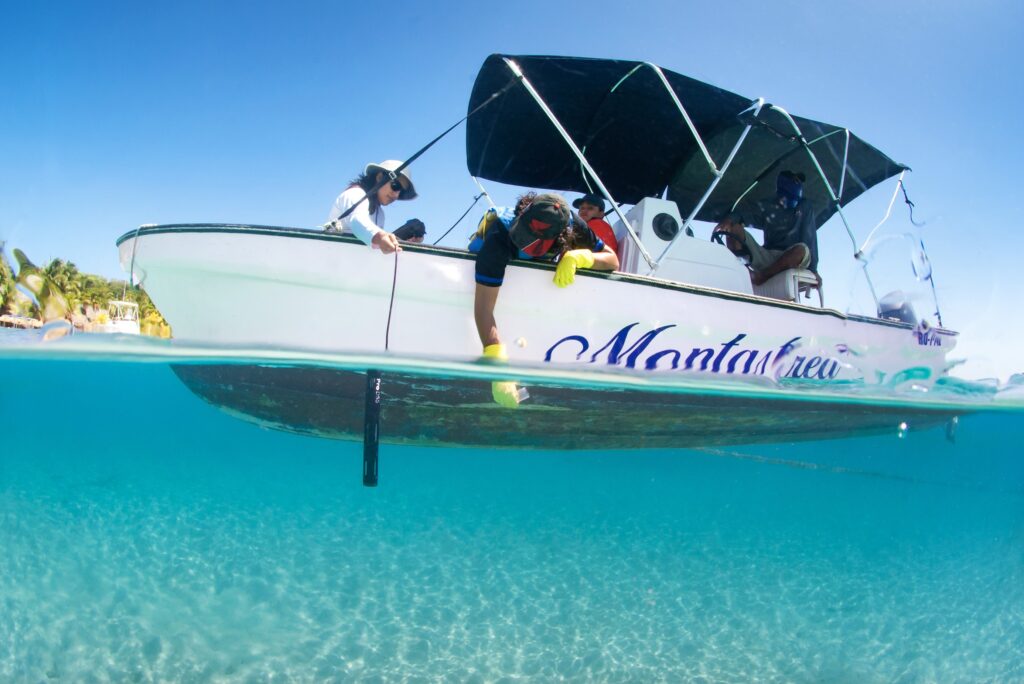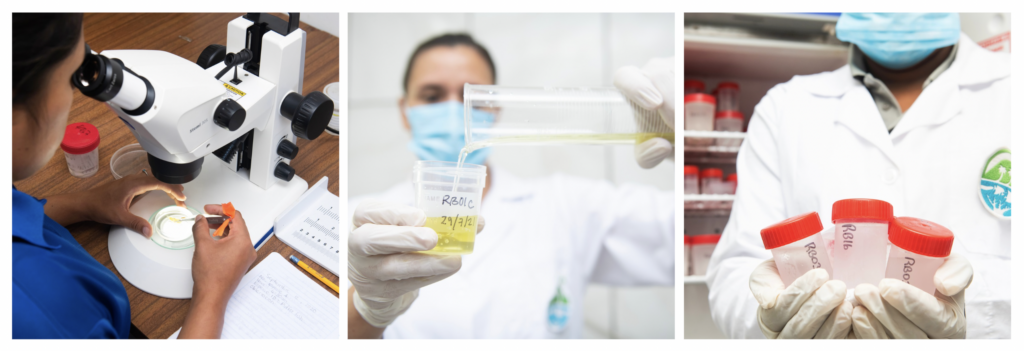A Critical Component of Wastewater Treatment
Water quality monitoring is an essential aspect of informing and advocating for conservation initiatives that reduce the threats of untreated or improperly treated wastewater. It’s important that monitoring methods are consistent, which is why we created the Water Quality handbook as a resource for local governments, managers and general partners interested in understanding their own systems and informing management on water quality.
Here are the key components of water quality monitoring in the context of wastewater treatment:
Initial Assessment and Baseline Data Collection
The initial assessment of water quality involves identifying potential sources of pollution, evaluating the extent of contamination, and understanding the impacts on marine ecosystems. This step is crucial before investing in a full-scale monitoring program and involves gathering existing data from local, national, and global datasets.
Key Components of Initial Assessment
Source Identification
Determine the primary sources of water pollution, such as urban runoff, industrial discharges, or agricultural practices.
Extent of Pollution
Assess the spatial and temporal distribution of pollutants in coastal waters.
Impact Evaluation
Understand the ecological impacts on coral reefs and other marine life, as well as potential human health risks.
Before identifying a solution, you need to understand the socioeconomics of your community and the health of your coastal water quality. It is crucial to conduct an initial assessment to establish baseline water quality conditions and baseline homeowner information (how many homes will connect to a system, what’s needed). This involves:
- Sampling and Analysis: Collecting water samples from various points in the proposed discharge area to measure parameters such as pH, temperature, dissolved oxygen, turbidity, chlorophyll a, nutrients (nitrogen and phosphorus),, and pathogens.
- Environmental Impact Study: Assessing the potential impact of the facility on local water bodies and ecosystems, including coral reefs, to identify sensitive areas and inform design decisions.

Designing the Monitoring Program
Monitoring involves the regular collection of water quality data to establish baselines and track changes over time. This includes both in-situ measurements and laboratory analyses of collected samples. A well-designed monitoring program is tailored to the specific needs and goals of the wastewater treatment facility. Key considerations include:
- Parameter Selection: Identifying critical water quality parameters to monitor based on the types of pollutants expected in the wastewater and the sensitivity of the receiving environment.
- Monitoring Locations: Determining strategic points for sampling that represent various pollution sources and control areas to provide comprehensive data including influent (incoming wastewater), effluent (treated wastewater), and various points within the treatment process.
- Frequency and Timing: Establishing a schedule for regular monitoring to capture variations in water quality over time, such as seasonal changes and peak usage periods. High-frequency sampling during events such as first flushes after rainfall, algal blooms, or pollution spills can be beneficial to capture this variability.
Implementing Continuous and Periodic Monitoring
Effective water quality monitoring involves a combination of continuous and periodic sampling:
- Continuous Monitoring: Utilizing automated sensors and real-time data loggers to continuously track key parameters like pH, dissolved oxygen, and turbidity. This provides immediate feedback on the performance of the treatment process and helps detect anomalies.
- Periodic Sampling: Conducting manual sampling at specified intervals to analyze a broader range of parameters, including chemical and biological contaminants. These samples are sent to accredited laboratories for detailed analysis.
Key Sampling Parameters
- Surface Temperature: An indicator of global climate change, crucial for various oceanographic and climatological calculations.
- pH: Essential for understanding water acidity, which significantly affects the health and survival of marine life.
- Total Suspended Solids: High levels can reduce light penetration, impairing photosynthesis and inhibiting coral growth.
- Dissolved Oxygen: Low levels can lead to marine life mortality and serve as an indicator of nutrient pollution and eutrophication.
- Conductivity: Important for determining water salinity and for various analytical calculations and instrumentation calibration.
- Salinity: Changes can indicate freshwater runoff, evaporation rates, or the mixing of different water masses.
- Turbidity: Indicates the presence of suspended particles, which can be a result of nutrient runoff and potential phytoplankton blooms.
- Chlorophyll: A proxy for phytoplankton biomass, indicating the level of nutrient contamination and primary productivity.
- Pathogen Indicators
- Enterococcus: A specific indicator of human wastewater contamination, used to assess water quality and health risks.
- Total Coliforms: A general indicator of fecal contamination, signaling the presence of pathogenic microorganisms in water.
- Nutrient Parameters
- Nitrate (NO3): Indicates the presence of nutrients from wastewater and agricultural runoff, promoting algae growth and potential eutrophication.
- Nitrite (NO2): An intermediate product of nitrification and denitrification processes, important in assessing nitrogen cycling.
- Ammonia (NH3): Produced from human wastewater, agricultural runoff, industrial discharges, natural decomposition, and atmospheric deposition; toxic to aquatic life at high concentrations.
- Total Phosphorus (P): A limiting nutrient for algae growth, key to assessing the impact of wastewater and agricultural runoff on water quality.
- Isotope Analysis
- Nitrogen-15 (N15): Measures the proportion of nitrogen in algae, helping to trace the sources of nitrogen, particularly from human wastewater.
- Carbon-13 (C13): Used to determine the sources of organic carbon in marine environments, distinguishing between terrestrial and marine inputs and understanding food web dynamics.
Field Safety and Protocols
Safety is paramount during sample collection. Teams must follow strict protocols, including wearing gloves and using sterile containers to prevent contamination. All samples are labeled and handled with care to ensure data integrity. Additionally, field safety plans include detailed information about participants, vessel descriptions, emergency contacts, and required safety equipment such as first aid kits, life jackets, and radios.
Quality Assurance and Quality Control (QA/QC)
QA/QC measures are critical for reliable data. This includes using blank samples to detect contamination, fortified blanks for accuracy checks, and fortified matrices to account for sample-specific variations. All protocols follow established standards to ensure consistency and reliability.

Evaluation
Data Analysis and Interpretation
Evaluation involves analyzing the collected data to identify trends, assess the effectiveness of wastewater treatment interventions, and inform adaptive management strategies. This involves:
- Statistical Analysis: Use statistical methods to interpret data and identify significant changes or trends.
- Impact Assessment: Evaluate the effectiveness of implemented pollution control measures on water quality and reef health.
- Reporting and Communication: Share findings with stakeholders, including policymakers, local communities, and funding organizations, to support informed decision-making.
Adaptive Management and Continuous Improvement
Water quality monitoring is not a one-time effort but an ongoing process that supports adaptive management and continuous improvement of the treatment facility. Key actions to ensure long-term monitoring and evaluation:
- Responsive Adjustments: Making operational adjustments in response to monitoring data to optimize treatment processes and address any identified issues promptly.
- Facility Upgrades: Using monitoring data to inform decisions about necessary upgrades or modifications to the facility to enhance its efficiency and effectiveness.
- Sustained Funding: Ensure ongoing financial support for continuous data collection and analysis.
- Partner/Community Engagement: Involve local communities and partners in the monitoring process to foster ownership and responsibility.
- Adaptive Management: Use evaluation results to refine and improve wastewater treatment and pollution mitigation strategies over time .
Systematic water quality monitoring, assessment, and evaluation are essential for identifying pollution sources and implementing targeted mitigation strategies, particularly in the context of wastewater treatment. This not only protects coral reefs but also supports the health and well-being of coastal communities. Through coordinated efforts, we aim to expand successful models like the one in Roatan to other regions, ensuring cleaner waters and healthier reefs globally.
